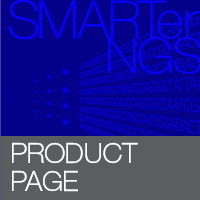In single-cell transcriptome studies, it is critical to obtain high-quality cDNA libraries from individual cells that represent the original in vivo mRNAs as closely as possible. To achieve this, we improved upon our existing commercially available mRNA-seq chemistry for single-cell transcriptome studies (the SMARTer Ultra Low Input RNA Kit for the Fluidigm C1 System; UL-v1). The SMART-Seq v4 Ultra Low Input RNA Kit for the Fluidigm C1 System (SS-v4) allows high-quality cDNA synthesis from up to 96 single cells that have been isolated and processed with the Fluidigm C1 Single-Cell Auto Prep System. We have developed the "SMART-Seq v4" C1 script for single-cell RNA-seq employing the Open App IFC and new chemistry. While the original UL-v1 kit runs only with the IFC for mRNA Seq, the SS-v4 kit is compatible with both the IFC for mRNA Seq and the IFC for Open App. No matter which IFC is used, the SS-v4 kit uses the SMART-Seq v4 script. The IFC for Open App was used for the SS-v4 experiments reported here.
The improved chemistry built into the SMART-Seq v4 Ultra Low Input RNA Kit for the Fluidigm C1 System:
- Incorporates locked nucleic acid (LNA) technology integrated with SMART technology. These improvements lead to higher sensitivity, higher cDNA yield, and more genes detected.
- Uses SeqAmp polymerase, which results in better representation of high-GC genes.
- Enables better reproducibility, which indicates reduced technical variation, increasing the likelihood of discovering true biological variation.
In addition to differences in chemistry, the newer SMART-Seq v4 script (SS-v4 chemistry) and the original mRNA-Seq script (UL-v1 chemistry) have different protocols. The lysis and RT thermal cycling conditions are the same in the SS-v4 and UL-v1 protocols; however, a variety of reagents and enzymes (for lysis, RT, and PCR), and PCR conditions vary between the two protocols. (For example, the SMART-Seq v4 script uses SeqAmp polymerase and conducts PCR at a higher temperature.) Key differences are highlighted in the table below.
| SS-v4 (SMART-Seq v4 script) | UL-v1 (mRNA Seq script) | |||
|---|---|---|---|---|
| Lysis conditions | 3 min 72°C 10 min 4°C 1 min 25°C |
|||
| Lysis reagents | 10X lysis buffer | Dilution buffer | ||
| RT conditions | 90 min 42°C 10 min 70°C |
|||
| RT reagents | SMART-seq v4 Oligonucleotide | SMARTer II A Oligonucleotide | ||
| PCR conditions | 1 cycle | 1 min 98°C | 1 cycle | 1 min 95°C |
| 5 cycles | 20 sec 98°C 4 min 59°C 6 min 68°C |
5 cycles | 20 sec 95°C 4 min 58°C 6 min 68°C |
|
| 9 cycles | 20 sec 95°C 30 sec 65°C 6 min 68°C |
9 cycles | 20 sec 95°C 30 sec 64°C 6 min 68°C |
|
| 7 cycles | 30 sec 95°C 30 sec 65°C 7 min 68°C |
7 cycles | 30 sec 95°C 30 sec 64°C 7 min 68°C |
|
| 1 cycle | 10 min 72°C | 1 cycle | 10 min 72°C | |
| PCR reagents | SeqAmp DNA Polymerase | Advantage 2 Polymerase | ||
Comparison of sample preparation conditions. To employ the SS-v4 chemistry on C1 IFCs, a SMART-Seq v4 script was written using the C1 Script Builder (v.2.0.10). The existing Fluidigm mRNA Seq script that is built into the C1 system was used for the UL-v1 experiments (Protocol PN 100-7168, Fluidigm Corporation).






